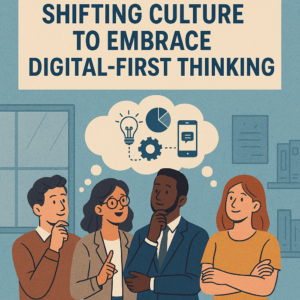
Digital transformation is no longer a buzzword—it’s a mandate. But while nearly every organization is investing in digital initiatives, not all of them are succeeding. In fact, a study by Boston Consulting Group found that 70% of digital transformations fail to achieve their objectives (BCG). The difference often comes down to digital transformation leadership leadership.
Great digital transformation leaders don’t just manage change; they architect it. They move beyond tech upgrades and process optimization to reimagine the business in ways that unlock growth, enhance customer experiences, and empower employees. Here’s what sets them apart.
1. Great Digital Leaders Begin with Purpose
The best digital transformation leadership understands that digital tools are just a means to an end. They begin by articulating a clear purpose for the transformation: Is it to better serve customers? To future-proof the business? To create more agile and data-informed decision-making?
They communicate this purpose across the organization, anchoring every initiative to it. This ensures alignment, minimizes resistance, and creates emotional engagement from employees at every level. As Simon Sinek emphasizes in his TED Talk, “Start With Why,” people don’t buy what you do—they buy why you do it (Simon Sinek).
2. Building Digital Fluency for Transformation Success
Great digital leadership recognizes that transformation isn’t just for IT or marketing—it’s an enterprise-wide shift. They invest in building digital literacy at all levels, from the boardroom to the frontline. This doesn’t mean turning every employee into a data scientist, but it does mean:
- Training teams to interpret and use data
- Introducing agile methodologies
- Encouraging cross-functional collaboration
- Making tech tools accessible and intuitive
Leaders who invest in a culture of continuous learning and experimentation create organizations that can evolve alongside technology.
According to McKinsey & Company, companies that invest in workforce digital capabilities are 2.5x more likely to succeed in digital transformation (McKinsey).
3. Customer-Centric Digital Transformation Strategies
Many digital transformations stall because they focus inward—automating workflows, modernizing infrastructure, or cutting costs. Great leaders flip the script. They design from the outside in, starting with customer needs, pain points, and behaviors.
They invest in:
- Journey mapping
- Real-time voice-of-customer feedback loops
- Personalization engines
- Seamless omni-channel experiences
By focusing on delivering value to customers first, internal efficiencies tend to follow naturally. This customer-centric mindset turns transformation into a growth engine, not just a cost-cutting initiative.
4. Leading Digital Change with Agility and Experimentation
Digital transformation is complex and non-linear. Great digital transformation leadership resists the urge to over-engineer a rigid roadmap. Instead, they embrace agile frameworks and build capacity for experimentation.
They:
- Set a bold vision but allow flexible execution
- Pilot new ideas rapidly, learn from data, and pivot fast
- Create psychological safety for teams to fail forward
This adaptability creates a resilient organization that can respond to market shifts, new technologies, and customer expectations in real time.
Harvard Business Review reinforces this in their article, “The Hard Truth About Innovative Cultures,” which explains that high-performing innovative cultures balance freedom with discipline (HBR).
5. Aligning Digital Transformation Strategy with Business Goals
Great leaders don’t chase shiny objects. They avoid random acts of digital by aligning every technology investment with broader business objectives.
Whether implementing AI, automation, or analytics, they ask:
- How will this enhance our value proposition?
- How will it reduce friction for our customers or employees?
- How will we measure success?
They partner closely with CIOs, CFOs, and CMOs to ensure transformation is embedded into strategic planning, budgeting, and organizational design.
6. Digital Transformation KPIs That Drive Results
Too many transformations fail because success is poorly defined. Great digital transformation leadership develops clear KPIs tied to their transformation goals.
They track both leading and lagging indicators:
- Customer metrics: Net Promoter Score (NPS), retention, conversion rates
- Operational metrics: Time to market, automation rates, process error reduction
- Employee metrics: Engagement scores, digital adoption, upskilling completion
They use dashboards and scorecards to keep progress transparent and accountable, making data a central part of leadership conversations.
7. How Digital Leaders Drive Organizational Culture Change
Perhaps most importantly, successful digital transformation leadership understands that digital evolution is ultimately about people and culture. Technology can only go as far as culture allows.
They actively:
- Model the behaviors they expect (curiosity, adaptability, data-driven thinking)
- Recognize and reward collaboration and innovation
- Flatten hierarchies and break down silos
As noted by Deloitte in their Global Human Capital Trends report, companies with strong transformation leaders embed digital into the DNA of their culture, making change sustainable over the long term (Deloitte).
8. Transparent Communication in Digital Leadership
In times of change, silence breeds anxiety. Great digital transformation leaders over-communicate. They share:
- Vision and rationale for change
- Successes and learnings
- Course corrections and candid challenges
They use multiple formats—videos, town halls, email updates, Slack channels—and make communication two-way, inviting feedback and surfacing concerns early.
9. Designing Scalable Digital Transformation Initiatives
Many organizations get stuck in pilot purgatory. Great leaders think beyond isolated wins and design for enterprise scalability from day one. This means:
- Investing in platforms, not point solutions
- Establishing data governance and integration standards
- Considering change management early
This enterprise thinking ensures that innovations don’t remain siloed or stall out after initial success.
10. Developing Future-Focused Digital Leadership Teams
Finally, great transformation leaders don’t try to carry the full burden themselves. They mentor, empower, and develop digital leadership throughout the organization.
They:
- Sponsor internal innovation programs
- Identify and support digital champions at all levels
- Create rotational roles and cross-functional squads
This creates a leadership bench that can continue to drive transformation long after the original leader moves on.
Final Thought
Digital transformation isn’t a one-time project—it’s a capability. The leaders who do it well treat it as a journey of continuous reinvention. They balance vision with execution, people with technology, and boldness with empathy.
As your organization navigates its own transformation, consider this: Are you managing digital change—or are you leading it? The difference can shape your organization’s relevance, resilience, and long-term success.
Other Articles:






